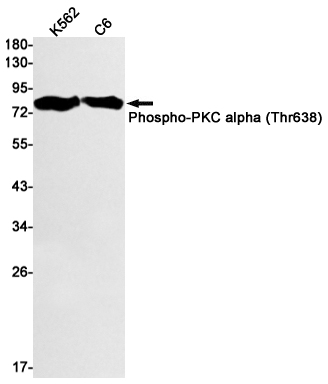Product Detail
Product NamePKC alpha (Phospho-Thr638) Rabbit mAb
Clone No.S09-7C7
Host SpeciesRecombinant Rabbit
ClonalityMonoclonal
IsotypeRabbit IgG
PurificationAffinity Purified
ApplicationsWB IHC
Species ReactivityHuman,Mouse,Rat
Immunogen DescA synthetic phosphopeptide corresponding to residues surrounding Thr638 of human PKC alpha
ConjugateUnconjugated
Other NamesEC 2.7.11.13; KPCA; PKC III; PKC-A; PKC-III; PKC-alpha; PRKACA; PRKCA; Protein kinase C; alpha type; kinase PKC-alpha;
Accession NoSwiss-Prot:P17252
GeneID:5578
Uniprot
P17252
Gene ID
5578
Calculated MWCalculated MW: 77 kDa; Observed MW: 80 kDa
Concentration0.3 mg/ml
Formulation50mM Tris-Glycine(pH 7.4), 0.15M NaCl, 40% Glycerol, 0.01% Sodium azide and 0.05% BSA
StorageStore at 4˚C short term. Aliquot and store at -20˚C long term. Avoid freeze/thaw cycles.
Application Details
WB: 1/2000; IHC: 1/50;
Western blot detection of Phospho-PKC alpha (Thr638) in K562,C6 cell lysates using Phospho-PKC alpha (Thr638) Rabbit mAb(1:1000 diluted).Predicted band size:77kDa.Observed band size:80kDa.
Immunohistochemistry of Phospho-PKC alpha (Thr638) in paraffin-embedded human colon cancer tissue using Phospho-PKC alpha (Thr638) Rabbit mAb at dilution 1/100
Calcium-activated, phospholipid- and diacylglycerol (DAG)-dependent serine/threonine-protein kinase that is involved in positive and negative regulation of cell proliferation, apoptosis, differentiation, migration and adhesion, tumorigenesis, cardiac hypertrophy, angiogenesis, platelet function and inflammation, by directly phosphorylating targets such as RAF1, BCL2, CSPG4, TNNT2/CTNT, or activating signaling cascade involving MAPK1/3 (ERK1/2) and RAP1GAP. Involved in cell proliferation and cell growth arrest by positive and negative regulation of the cell cycle. Can promote cell growth by phosphorylating and activating RAF1, which mediates the activation of the MAPK/ERK signaling cascade, and/or by up-regulating CDKN1A, which facilitates active cyclin-dependent kinase (CDK) complex formation in glioma cells. In intestinal cells stimulated by the phorbol ester PMA, can trigger a cell cycle arrest program which is associated with the accumulation of the hyper-phosphorylated growth-suppressive form of RB1 and induction of the CDK inhibitors CDKN1A and CDKN1B. Exhibits anti-apoptotic function in glioma cells and protects them from apoptosis by suppressing the p53/TP53-mediated activation of IGFBP3, and in leukemia cells mediates anti-apoptotic action by phosphorylating BCL2. During macrophage differentiation induced by macrophage colony-stimulating factor (CSF1), is translocated to the nucleus and is associated with macrophage development. After wounding, translocates from focal contacts to lamellipodia and participates in the modulation of desmosomal adhesion. Plays a role in cell motility by phosphorylating CSPG4, which induces association of CSPG4 with extensive lamellipodia at the cell periphery and polarization of the cell accompanied by increases in cell motility. During chemokine-induced CD4+ T cell migration, phosphorylates CDC42-guanine exchange factor DOCK8 resulting in its dissociation from LRCH1 and the activation of GTPase CDC42 (PubMed:28028151).
If you have published an article using product 52098, please notify us so that we can cite your literature.




 Yes
Yes



